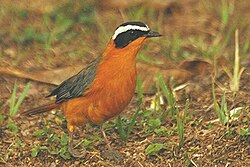White-browed robin-chat
| White-browed robin-chat | |
|---|---|

| |
| Song recorded in Chepareria, Kenya | |
| Scientific classification | |
| Domain: | Eukaryota |
| Kingdom: | Animalia |
| Phylum: | Chordata |
| Class: | Aves |
| Order: | Passeriformes |
| Family: | Muscicapidae |
| Genus: | Cossypha |
| Species: | C. heuglini
|
| Binomial name | |
| Cossypha heuglini Hartlaub, 1866
| |
The white-browed robin-chat (Cossypha heuglini), also known as Heuglin's robin,[2] is a species of bird in the family Muscicapidae. Found in east, central and southern Africa,[3] its natural habitats include riverine forest and thickets, and it is also found near humans. The IUCN classifies it as a least-concern species.
Taxonomy
Hartlaub described the species from Sudan in 1866.[4] The specific epithet is derived from Martin Theodor von Heuglin.[5] Three subspecies are recognized: Cossypha heuglini subrufescens ranging from Gabon to western Angola; C. h. heuglini from the southern parts of Chad and Sudan to eastern Angola, Botswana, and northern South Africa; and C. h. intermedia from southern Somalia to northeastern South Africa.[3]
Description

The white-browed robin-chat is 19–20 cm (7.5–7.9 in) long and weighs 29–51 g (1.0–1.8 oz).[4] The crown and face are black, and there is a white supercilium over the dark brown eye.[4][6] The back is olive grey-brown, and the rump is rufous. The two central tail feathers are olive-brown, and the other feathers are orange-rufous. The flight feathers and wing coverts are grey-brown, and the underwing coverts are rufous. The underparts are bright orange-rufous. The beak is black, and the legs are pinkish-brown, brownish grey, or dark brown.[4] The female is a little smaller than the male. The juvenile bird has a brown head and rufous-brown marks on its back. Its throat is pale, its breast is pale orange-buff, and its belly is pale orange.[4]
Distribution and habitat
The range includes Angola, Botswana, Burundi, Cameroon, Central African Republic, Chad, Republic of the Congo, Democratic Republic of the Congo, Eswatini, Ethiopia, Gabon, Kenya, Malawi, Mozambique, Namibia, Rwanda, Somalia, South Africa, South Sudan, Sudan, Tanzania, Uganda, Zambia, and Zimbabwe.[1] Its habitats include riverine forests, thickets, and also gardens.[7] In East Africa it can be found up to 2,200 m (7,200 ft) above sea level, but in the part of its range south of the Limpopo River, it generally occurs at elevations below 1,000 m (3,300 ft).[4] In South Africa, its range in KwaZulu-Natal expanded south from the 1950s to the 1970s, but the damage caused by a tropical cyclone in 1987 may have stopped the expansion.[7]
Behavior and ecology
The diet consists of ants, termites, beetles, some other insects and arthropods, frogs, and fruits. It bathes in water.[4]
Vocalizations
The white-browed robin-chat's contact calls include repeated pit-porlee, chiiritter-porlii and da-da-tee and end with da-teee or chickle-ter-tweep.[4] The alarm call is takata-kata-kata.[2] The melodious song, usually given at dawn and dusk, is quiet at first and then becomes louder; it consists of pip-pip-uree, don't-you-do-it or tirrootirree phrases that can be repeated more than ten times.[8] When singing loudly, its beak is wide open and its breast is inflated with its tail moving with each note sung. Pairs may sing in duet.[4]
Breeding
Around the Equator, the bird probably breeds in all months of the year, and in East Africa, it breeds during the two wet seasons.[4] In southern Africa, breeding has been recorded from July to May.[7] It is monogamous. There are usually two and sometimes three broods per year. The female builds the nest, which is made of dead leaves, twigs, and other plant material and built in a tree hole, stump, sapling, roots, riverbank, or on the ground.[4] It has been observed nesting near humans, on occupied buildings' walls and trellises covered with climbing plants.[4][7] There are two to three eggs in a clutch. The nest is often parasitized by the red-chested cuckoo. This robin-chat is territorial and defends its territory by giving alarm calls and sometimes by attacking the intruder.[4]
Status
C. heuglini has a large range and a stable population trend, so the IUCN Red List has assessed it to be of least concern.[1]
References
- ^ a b c BirdLife International (2016). "Cossypha heuglini". IUCN Red List of Threatened Species. 2016: e.T22709822A94224177. doi:10.2305/IUCN.UK.2016-3.RLTS.T22709822A94224177.en. Retrieved 16 November 2021.
- ^ a b Stevenson, Terry; Fanshawe, John (2004). Birds of East Africa: Kenya, Tanzania, Uganda, Rwanda, Burundi. A&C Black. p. 332. ISBN 9780713673470.
- ^ a b Gill, F.; Donsker, D. (eds.). "Chats, Old World flycatchers". IOC World Bird List Version 7.1. Retrieved 22 January 2017.
- ^ a b c d e f g h i j k l m Clement, Peter (2016). Robins and Chats. Bloomsbury. pp. 332–334. ISBN 9781408155967.
- ^ Jobling, James A. (2010). Helm Dictionary of Scientific Bird Names. Bloomsbury. p. 191. ISBN 9781408133262.
- ^ Hancock, Peter; Weiersbye, Ingrid (2015). Birds of Botswana. Princeton University Press. p. 322. ISBN 9781400874170.
- ^ a b c d T. B. Oatley. "Heuglin's Robin" (PDF). The Atlas of Southern African Birds.
- ^ Newman, Kenneth (2002). Newman's Birds of Southern Africa. Struik. p. 344. ISBN 9781868727353.
